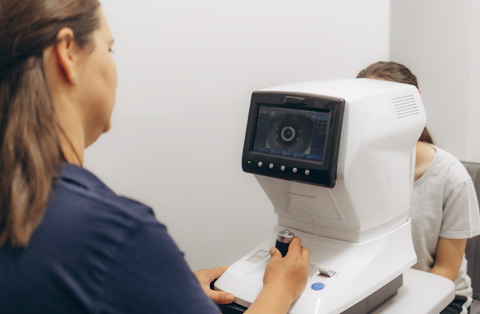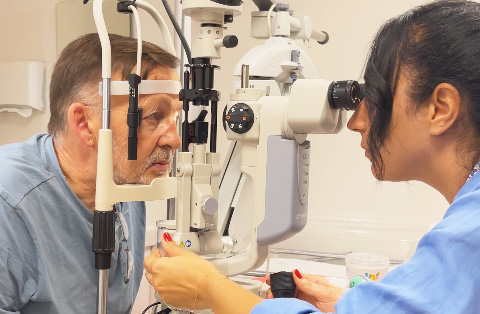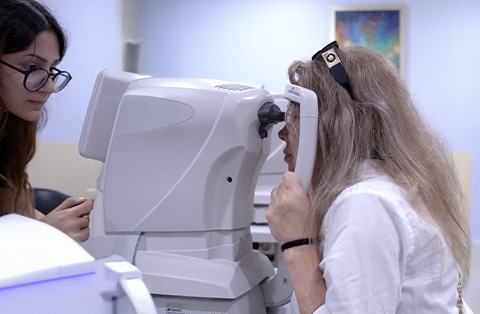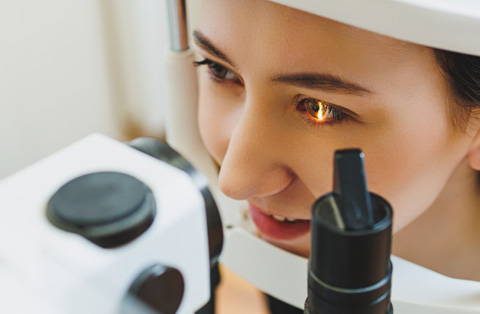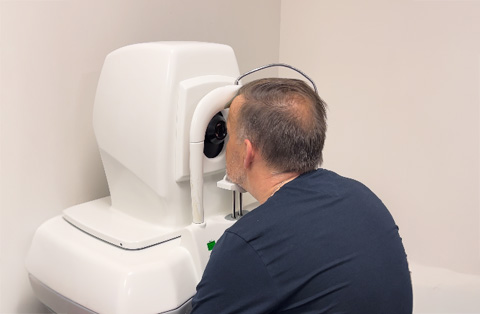Clear vision without glasses or contact lenses: PRK laser eye surgery offers a safe, lasting solution for those seeking freedom from refractive errors, even if LASIK isn’t an option.
What is PRK Eye Surgery?
PRK (Photorefractive Keratectomy) is a type of laser eye surgery. It corrects refractive errors such as myopia (nearsightedness), hyperopia (farsightedness), and astigmatism. PRK was the first type of laser vision correction developed. It came before LASIK and is still commonly used today.
In PRK, the surgeon removes the thin outer layer of the cornea, called the epithelium. Then, they use an excimer laser to reshape the corneal tissue underneath. This changes how light enters the eye and focuses on the retina. After the laser treatment, the epithelium grows back naturally over a few days.
PRK does not involve creating a corneal flap, which makes it a good option for patients with thin corneas or certain eye conditions.
How does PRK differ from LASIK?
The main difference between PRK and LASIK is how the surgeon accesses the cornea.
In PRK, the outer layer of the cornea (epithelium) is gently removed. The laser then reshapes the surface underneath. The epithelium grows back naturally over a few days.
In LASIK, the surgeon creates a thin flap in the cornea using a blade or laser. They lift this flap, apply the laser to reshape the cornea, and then reposition the flap.
Because PRK does not involve creating a flap, it is often recommended for patients with thin corneas, dry eyes, or active lifestyles where eye injuries are more likely. However, PRK has a longer recovery time. It may also involve more discomfort in the first few days after laser surgery.
Both procedures aim to improve vision and reduce the need for glasses or contact lenses. The long-term visual results of PRK and LASIK are similar.
Who should consider PRK Surgery?
PRK procedure is a suitable option for many patients, especially those who may not be ideal candidates for LASIK. It is often recommended in the following situations:
People with thin corneas: PRK does not require creating a flap, so it preserves more corneal tissue.
Patients with dry eye syndrome: PRK may cause fewer long-term dry eye symptoms than LASIK.
Patients with active lifestyles: Athletes or people in high-risk professions may benefit from PRK, as there is no flap that can be dislodged by trauma.
Those with corneal surface irregularities: PRK can help smooth the surface of the cornea.
Before recommending PRK, an eye surgeon will perform a full eye exam. This includes measuring corneal thickness, checking vision stability, and reviewing eye health history. PRK may not be suitable for patients with autoimmune diseases, certain eye conditions, or unstable vision.
What are the benefits of PRK Laser Vision Correction?
PRK offers several important benefits, especially for patients who are not good candidates for LASIK. The results are stable and long-lasting. Vision improves significantly once the eyes heal.
Here are the main benefits of PRK:
No corneal flap: This reduces the risk of flap-related complications. It also makes PRK safer for patients with thin corneas.
Suitable for more patients: People with mild corneal irregularities or dry eyes may do better with PRK than with LASIK.
Permanent vision correction: Once healing is complete, the results are lasting. Many patients no longer need glasses or contact lenses.
Lower risk of long-term dry eye: PRK may disturb fewer corneal nerves, which can help maintain better natural tear production.
Proven track record: PRK has been used for over 30 years with consistent and predictable outcomes.
Healing process is longer than LASIK, the visual outcomes are comparable. Most patients achieve 20/20 vision or better after recovery.
What Happens During a PRK Laser Eye Surgery Procedure?
PRK is a quick and simple outpatient procedure. It usually takes about 15 minutes for both eyes.
There is no cutting or flap involved. The eye starts healing right after the refractive surgery. The contact lens is removed after a few days, once the surface has healed.
Step-by-step guide to the Photorefractive Keratectomy Procedure
Here is a clear and medically accurate step-by-step guide to the PRK procedure:
Preoperative preparation:
The patient lies down comfortably. The surgeon applies numbing eye drops to prevent pain. An eyelid holder keeps the eye open.
Removal of the epithelium:
The surgeon gently removes the thin outer layer of the cornea. This can be done with a soft brush, alcohol solution, or a blunt surgical tool.
Laser reshaping:
An excimer laser is used to reshape the underlying corneal tissue. The laser removes microscopic layers to correct the refractive error. The laser is computer-guided and precisely controlled.
Application of medication:
Mitomycin-C (MMC) may be applied for a few seconds to reduce the risk of corneal haze, especially in higher corrections.
Placement of bandage lens:
A soft, clear contact lens is placed over the cornea. It acts as a bandage to protect the eye and support healing.
Post-procedure care:
The patient rests for a short time. Then, they receive instructions and medications such as antibiotic and anti-inflammatory eye drops. The bandage lens stays in place for 4 to 7 days and is removed once the epithelium has healed.
The entire process is painless due to numbing drops. Some discomfort can occur after the procedure during the healing phase.
How is the Cornea reshaped during PRK?
During PRK, the cornea is reshaped using an excimer laser. This laser removes very thin layers of tissue from the surface of the cornea. It does not cut or burn. Instead, it uses cool ultraviolet light to reshape the cornea with high precision.
The reshaping depends on the type of vision problem:
For myopia (nearsightedness): The laser flattens the central part of the cornea to reduce its focusing power.
For hyperopia (farsightedness): The laser steepens the central cornea to improve focus.
For astigmatism: The laser smooths an uneven cornea into a more regular shape.
The goal is to adjust the way light enters the eye so that it focuses directly on the retina. This improves vision and reduces the need for glasses or contact lenses. The reshaping is customized for each patient, based on detailed eye measurements taken before the procedure.
How is the Recovery from PRK Surgery?
Recovery from PRK takes longer than LASIK, but most patients heal well and achieve clear vision.
Here is what to expect during the recovery:
First few days:
The eye may feel sore or irritated. Light sensitivity, tearing, and blurred vision are common. The bandage contact lens stays in place to protect the healing surface.
Day 4 to 7:
The epithelium usually heals within this time. The doctor removes the contact lens once healing is confirmed.
First few weeks:
Vision gradually improves. Some fluctuations in clarity are normal. Most patients return to work within a week.
1 to 3 months:
Vision continues to sharpen and stabilize. Final results may take a few months, especially for higher corrections.
During recovery, patients use antibiotic and anti-inflammatory eye drops. These prevent infection and reduce inflammation. Artificial tears help relieve dryness. It is important to avoid rubbing the eyes and to follow all postoperative instructions carefully.
How to manage Dry Eye symptoms post-surgery?
Dry eye is a common symptom after PRK surgery. It usually improves as the eyes heal. Proper care during recovery helps reduce discomfort and protect the eye’s surface.
Here’s how to manage dry eye after PRK:
Use artificial tears:
Preservative-free lubricating drops keep the eyes moist. Use them often, even if symptoms are mild.
Follow medication instructions:
Anti-inflammatory drops prescribed after the refractive surgery help control irritation and support healing.
Avoid screen overuse:
Long periods of screen time can reduce blinking. This worsens dryness. Take regular breaks and blink more often.
Stay hydrated:
Drinking enough water helps keep your eyes moist from the inside.
Use a humidifier:
Dry air, especially in air-conditioned rooms, can make symptoms worse. A humidifier adds moisture to the air.
Avoid smoke and wind:
Protect your eyes from harsh environments. Wear sunglasses when outside to reduce exposure.
Most patients notice improvement in dry eye symptoms within weeks. If dryness continues, the eye doctor may suggest other treatments such as eye gels, punctal plugs, or special prescription drops.
When can normal activities be resumed?
Most patients can return to normal daily activities within 5 to 7 days after PRK. However:
Work and light tasks: Usually after 1 week.
Driving: When vision is clear enough, often within 1 to 2 weeks.
Exercise: Light activity after 1 week, avoid contact sports for 1 month.
Swimming and eye makeup: Avoid for at least 2 weeks.
Always follow your surgeon’s advice, as healing times can vary.
What is the PRK Eye Surgery Cost?
The cost of PRK (Photorefractive Keratectomy) eye surgery varies significantly across countries, influenced by factors such as healthcare infrastructure, surgeon expertise, and technological advancements.
Average PRK Surgery Costs by Region
United States: Approximately $2,500 to $5,000 for both eyes.
United Kingdom: Around £1,500 to £2,000 per eye.
Western Europe: Between €1,500 and €3,000 per eye.
Türkiye: Approximately $1,100 to $1,500 for both eyes.
Türkiye: Affordable Excellence in Eye Care
Türkiye has emerged as a leading destination for PRK surgery, offering a combination of affordability and high-quality medical care. Several factors contribute to this:
Cost-Effective Healthcare System: Lower operational costs and favorable currency exchange rates make treatments more affordable for international patients.
Advanced Medical Facilities: Clinics are equipped with state-of-the-art technology and adhere to international standards.
Experienced Surgeons: Many ophthalmologists in Türkiye have extensive experience and training from reputable institutions.
Comprehensive Packages: All-inclusive packages often cover surgery, accommodation, transfers, and post-operative care, providing convenience and transparency.
Choosing Türkiye for PRK surgery allows patients to receive world-class treatment at a fraction of the cost compared to many Western countries, without compromising on quality or safety.
How does the Cost of PRK compare with LASIK?
PRK and LASIK are similar in price, but small differences exist depending on location and technology used.
In general:
PRK may be slightly less expensive than LASIK. This is because it does not require creating a corneal flap, which may involve additional equipment.
LASIK costs can be higher due to the use of femtosecond lasers for flap creation or wavefront-guided technology.
However, the difference in cost is usually modest. In most clinics, both procedures fall within the same price range.
In Türkiye, both PRK and LASIK are offered at significantly lower costs compared to the US, UK, and Western Europe. Despite the affordability, clinics in Türkiye offer high medical standards and experienced eye surgeons. This balance of cost and quality makes Türkiye a preferred destination for many international patients.
